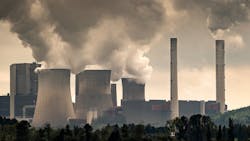EPA finalizes standards to reduce pollution from fossil fuel-fired power plants
The U.S. Environmental Protection Agency (EPA) has finalized a suite of rules that are designed to reduce pollution from fossil fuel-fired power plants. The department hopes these rules will reduce climate, air, water, and land pollution from the power sector. The four rules, which were finalized under separate authorities including the Clean Air Act, Clean Water Act, and Resource Conservation and Recovery Act, are engineered to support the power sector as it transitions to a clean energy economy. The standards offer compliance timelines that allow power companies to plan how they will meet electricity demand while reducing pollution.
Below is a brief outline of the four final rules:
- Existing coal-fired and new natural gas-fired power plants must control 90% of their carbon pollution
- Coal-fired power plants must reduce pollutants discharged through wastewater by more than 660 million pounds per year
- The Mercury and Air Toxics Standards (MATS) for coal-fired power plants has been updated, which will tighten the emissions standard for toxic metals by 67%
- Coal ash, which was placed in previously unregulated areas, is now required to be safely managed
What people are saying
In a recent quote, EPA Administrator Michael S. Regan said, “Today, EPA is proud to make good on the Biden-Harris Administration’s vision to tackle climate change and to protect all communities from pollution in our air, water, and in our neighborhoods. By developing these standards in a clear, transparent, inclusive manner, EPA is cutting pollution while ensuring that power companies can make smart investments and continue to deliver reliable electricity for all Americans.”
National Climate Advisor Ali Zaidi added, “This year, the United States is projected to build more new electric generation capacity than we have in two decades – and 96 percent of that will be clean. President Biden’s leadership has not only sparked an unprecedented expansion in clean electricity generation, his leadership has also launched an American manufacturing renaissance. America is now a magnet for private investment, with hundreds of billions of dollars committed and 270,000 new clean energy jobs created. This is how we win the future, by harnessing new technologies to grow our economy, deliver environmental justice, and save the planet for future generations.”
Latest EPA news
EPA issues stronger clean air standard for chemical plants
The rule will affect approximately 200 plants that make synthetic organic chemicals and a variety of polymers and resins.
Scrap metal facility fined $145K for failing to control stormwater runoff and violating the Clean Water Act
This uncontrolled runoff could result in the Kansas River becoming polluted.
Which manufacturing plants in the U.S. are the most energy efficient?
Only facilities in the top 25% of energy efficiency in their sector can receive this certification.
Learn more about green manufacturing
‘Greenflation’ Is Driving Up Metal Prices. What’s a Manufacturer to Do?
Increasing energy costs, geopolitical conflicts, political roadblocks around growing mining capacity and the overall supply chain imbalance have no doubt contributed to current price levels, but demand is also higher than before.
Smart factories are green factories: How green product-lifecycle management is boosting sustainable manufacturing
With green PLM on every factory floor, manufacturers will realize their sustainability goals and drive better business outcomes.
Are Carbon Offsets Effective or Just Corporate Greenwashing?
When managed responsibly, offsetting projects can provide a viable course for sustainability initiatives.
About the Author
Alexis Gajewski
Senior Content Strategist
Alexis Gajewski has over 15 years of experience in the maintenance, reliability, operations, and manufacturing space. She joined Plant Services in 2008 and works to bring readers the news, insight, and information they need to make the right decisions for their plants. Alexis also authors “The Lighter Side of Manufacturing,” a blog that highlights the fun and innovative advances in the industrial sector.
